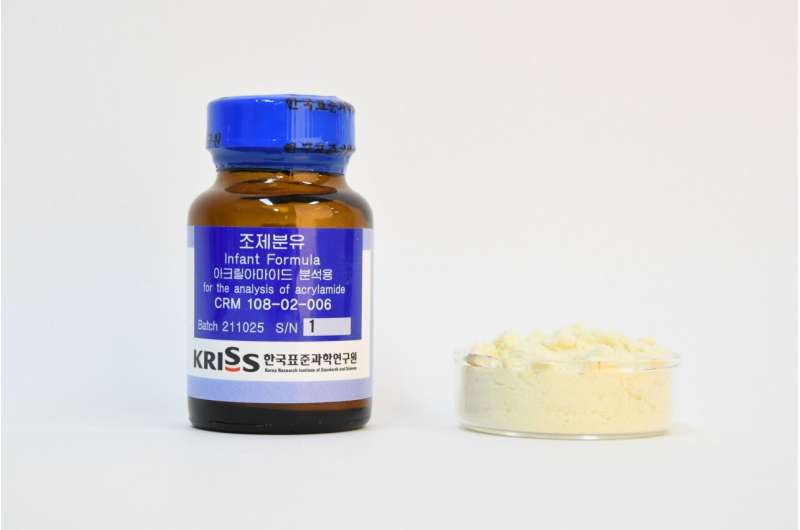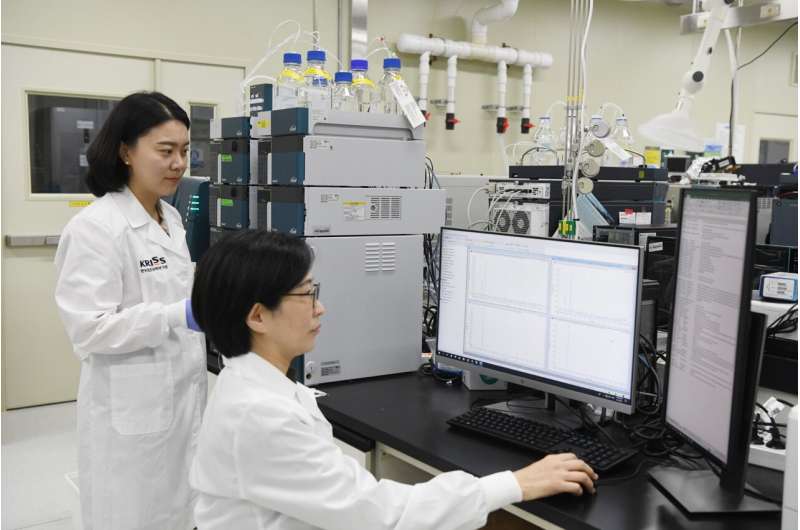This article has been reviewed according to Science X's editorial process and policies. Editors have highlighted the following attributes while ensuring the content's credibility:
fact-checked
peer-reviewed publication
proofread
Certified Reference Material unlocks precise acrylamide measurement in infant formula

The Korea Research Institute of Standards and Science (KRISS) has developed a Certified Reference Material (CRM) for the accurate analysis of low levels of acrylamide in infant formula.
Acrylamide is recognized as a probable carcinogen by the International Agency for Research on Cancer (IARC), an agency affiliated with the World Health Organization (WHO). It forms during the high-temperature cooking of carbohydrate-rich foods and is commonly found in items such as French fries, snacks, and coffee. Notably, acrylamide is also present in infant formula, making accurate quantification and management imperative.
In Europe, regulations targeting the reduction of acrylamide in food were initiated in 2017, and further strengthening of these regulations is anticipated this year. In South Korea, the Ministry of Food and Drug Safety established recommended standards for acrylamide levels in various foods in 2021 and has been overseeing compliance.
KRISS has achieved a significant breakthrough with the development of the CRM designed for the analysis of low-concentration acrylamide. It enables the precise examination of low-concentration acrylamide in food matrix, marking a pioneering achievement as the world's first CRM to improve the calibration and quality control of the analytical procedure.

KRISS has been at the forefront of the research related to international comparison of the acrylamide measurement since 2007, with a notable milestone being the development of a CRM for acrylamide analysis in potato chips in 2008.
The concentration of acrylamide in the new CRM is merely one-tenth of that found in the previously developed potato chip CRM, which allows for the precise measurement of trace amounts of acrylamide in food. Moreover, the new CRM was developed in accordance with the regulations by the European Commission (EC) for foods intended for infants and young children.
The infant formula CRM can be used to verify the analytical method for the acrylamide analysis at low levels of concentration. It is expected to enhance the measurement reliability of analytical laboratories and contribute to the refinement of evaluation systems.
Dr. Sunyoung Lee, a principal researcher at KRISS, said, "Given the high sensitivity to safety associated with infant foods, acrylamide benchmark levels are even stricter than those applied to other food categories. Consequently, thorough preventive management and heightened reliability of analysis are necessary. The distribution of this CRM aligns with the demand for establishing measurement standards in the food industry and will help alleviate public concerns regarding food safety."
The outcomes of this research were published in Analytical and Bioanalytical Chemistry .
More information: Sunyoung Lee et al, Development of a certified reference material for the accurate analysis of the acrylamide content in infant formula, Analytical and Bioanalytical Chemistry (2023). DOI: 10.1007/s00216-023-04779-4
Journal information: Analytical and Bioanalytical Chemistry
Provided by National Research Council of Science & Technology




















